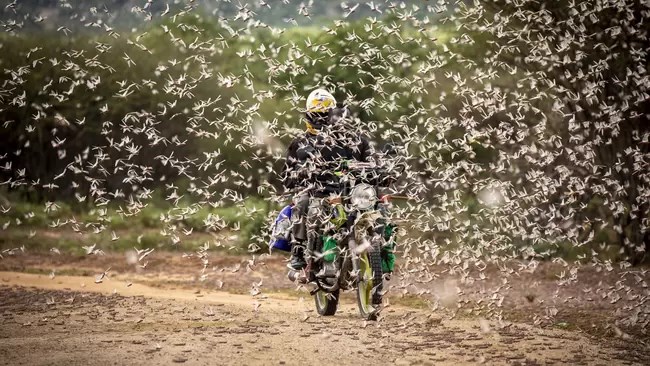
Tuesday April 21, 2020

Somalia is deploying surveillance teams and specialized vehicles to prevent desert locust swarms ravaging crops and pastures, and destroying the livelihoods of hundreds of thousands of people, United Nations and government officials said on Monday.
The worst outbreak in a generation has seen hungry swarms - some the size of cities - sweep across Somalia, Ethiopia and Kenya since December, destroying swathes of farm and grazing land.
Now, a second generation has spawned, just as crops are being planted for the new season, threatening the livelihoods of more than 20 million people in the Horn of Africa.
Somalia’s Agriculture Minister Said Hussein Iid said despite the challenges posed by the COVID-19 pandemic, authorities would do what they could to help farmers and herders at risk of losing their crops and livestock due to the locust infestation.
“Even in times of coronavirus, we must not forget the massive threat that desert locusts pose to Somalia’s food security and livelihoods,” said Hussein in a statement.
Locust swarms are not new to east Africa, but climate scientists say erratic weather linked to global warming has created ideal conditions for the insects to surge in numbers not seen in a quarter of a century.
Somalia declared the infestation a national emergency on Feb. 2, but the war-ravaged nation has struggled to control the swarms due to insecurity, remote locations and a lack of resources.
An estimated 4.5 million people in Somalia, including its breakaway regions of Somaliland and Puntland, are at risk of hunger and loss their livelihood, according to the U.N. Food and Agriculture Organization (FAO).
Rural areas and populations will be most affected by the infestation, including riverine farmers, agropastoralists, pastoralists and those already displaced, it added.
So far, just over 8% of the 360,000 hectares estimated to be affected has been treated with biopesticides, says the U.N. Food and Agriculture Organization (FAO).
International donors have committed almost $25 million - 40% of $57 million required - to help Somalia contain the infestation and help the recovery.
The FAO said Somalia had increased the number of vehicles mounted with sprayers to 33 and was hiring and training additional staff to fan out across country and conduct ground surveillance and control operations.
The country is also mobilizing three helicopters to conduct aerial spraying and has acquired 2,000 kilograms of biopesticides, it added.
FAO officials said there had been some delays in acquiring resources due to the COVID-19 pandemic.
“It is crucial that we keep reinforcing our collaboration and continue the hard work to contain the desert locust upsurge, and to protect lives and livelihoods,” said its Somalia representative Etienne Peterschmitt in a statement.
“Otherwise, we could end up in a serious food crisis by the end of the year,” he added.
The overthrow of President Siad Barre in 1991 plunged Somalia into almost three decades of violent turmoil - first at the hands of clan warlords then Islamist militants, Al Shabaab, which wants to topple Somalia’s central government.